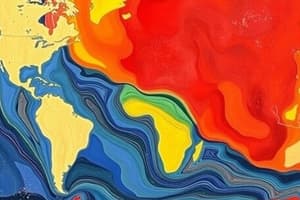Podcast
Questions and Answers
What are tectonic plates?
What are tectonic plates?
The surface of Earth is composed of tectonic plates that are driven by endogenic processes.
Who introduced the Continental Drift Theory?
Who introduced the Continental Drift Theory?
Alfred Wegener
Which continents were suggested to have fit together?
Which continents were suggested to have fit together?
- Europe
- Africa (correct)
- South America (correct)
- North America
What fossil evidence supports Continental Drift Theory?
What fossil evidence supports Continental Drift Theory?
The fit of continental shorelines is evidence for the Continental Drift Theory.
The fit of continental shorelines is evidence for the Continental Drift Theory.
The apparent shifting of climate belts indicates that the continents have been ____ over time.
The apparent shifting of climate belts indicates that the continents have been ____ over time.
Match the evidence with its description:
Match the evidence with its description:
What are tillites?
What are tillites?
What does the presence of coal in Antarctica suggest?
What does the presence of coal in Antarctica suggest?
Flashcards are hidden until you start studying
Study Notes
Continental Drift Theory
- Earth's crust is made of tectonic plates that move due to convection currents in the Earth's interior.
- The seven major continents are North America, South America, Europe, Africa, Asia, Australia, and Antarctica.
Alfred Wegener's Hypothesis
- In 1912, Alfred Wegener proposed the theory that the Earth had one giant landmass called Pangaea, meaning "all land".
- He suggested that Pangaea broke into smaller land pieces that drifted apart, forming the continents we know today.
Evidence Supporting Continental Drift
- Fit of Continental Shorelines: Continents like South America and Africa appear to fit together like puzzle pieces, suggesting they were once connected.
- Distribution of Glacial Sediments: Glacial sediments and rocks from the late Paleozoic era are found in southern parts of South America, Africa, India, Antarctica, and Australia, indicating these areas were once connected and near the South Pole.
- Paleoclimate: The shifting of climate belts over time suggests that continents have been moving.
- Distribution of Fossils: Similar fossils of land organisms are found across different continents, suggesting they were once connected and allowed for migration. For example, mesosaurus fossils are found in South America and Africa, and Glossopteris fossils are found on several continents.
- Distribution of Rocks: Distinctive rock formations on either side of the Atlantic Ocean, like the Appalachian Mountains, Caledonian Mountains, Scandinavian Mountains, and Atlas Mountains, suggest they were once a single mountain chain in Pangaea.
- Coal Deposits in Antarctica: The presence of coal deposits in Antarctica, which form from organic matter, suggests the continent was once located closer to the equator where plant and animal life flourished.
- Tillites: Deposits of rock debris left by glaciers (tillites) found in Africa, South America, India, and Australia hint that these areas were once near the South Pole and have since drifted away from each other.
Pole-Fleeing Force
- Wegener also suggested a "pole-fleeing force", a centrifugal force towards the equator, as a possible driver of continental drift.
- He also attempted to explain the westward drift of the Americas by invoking the gravitational force of the Sun and the Moon, but this theory is not widely accepted.
Studying That Suits You
Use AI to generate personalized quizzes and flashcards to suit your learning preferences.




